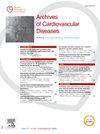利用胡文毒素和iberiotoxin研究ttx敏感钠通道(TTX-S Nav)和钙活化钾通道(KCa1.1)在心脏自动性中的作用
IF 2.3
3区 医学
Q2 CARDIAC & CARDIOVASCULAR SYSTEMS
引用次数: 0
摘要
心脏自动性是由心房结小鼠细胞(SANCs)的心脏自发产生动作电位(APs)的能力来定义的。这种能力是由于舒张期去极化期(DD),这是一个缓慢的去极化阶段,在心脏收缩周期的舒张期发展。DD是细胞内钙动态通道和肌膜离子通道之间复杂而尚未完全解开的相互作用的结果。在这些离子通道中,ttx敏感的钠离子通道(TTX-S Nav)和钙活化的钾离子通道(KCa1.1)与结内传导失败有关。目的通过两种不同的天然肽[胡文毒素- iv (HwTx-IV)和iberiotoxin (IbTx)]分别选择性抑制TTX-S Nav和KCa1.1离子通道,探讨其对心脏自动性的影响。方法采用膜片钳技术,用野生型小鼠分离的sanc进行离子电流和AP记录。将100 nM HWTX-IV灌注到SANCs或与50 nM TTX(阳性对照)联合灌注。在相同条件下,记录麻醉大鼠的心电图间期,在更完整的模型中证实结果。为了确定合适的条件来研究KCa1.1通道在SANCs中的作用,我们转染了KCa1.1通道的HEK细胞。应用NS 19504 (KCa1.1活化剂)10 μM, IbTx 300 nM, Paxillin 1 μM,记录KCa1.1电流。结果100 nM的HwTx-IV对TTX- s Nav通道的抑制作用诱导了钠电流的显著降低,而50 nM的TTX对TTX- s Nav通道的阻断作用没有增强。此外,100 nM HwTx-IV显示出SANCs自发放电频率显著降低13%,而50 nM TTX并没有进一步降低SANCs APs率,这证实了100 nM HwTx-IV对TTX- s导航通道的完全抑制作用。在麻醉大鼠中,注射50 μg/kg HwTx-IV可显著降低心率,但不影响心脏传导。在转染的HEK细胞中,10 μM NS可使KCa1.1电流加倍,而300 nM IbTx和1 μM Paxillin可100%阻断KCa1.1电流。结论抑制TTX-S Nav通道可显著降低SANCs自发性APs频率,提示其在心脏自动性中起重要作用。IbTx 300 nM在转染HEK的细胞中完全阻断KCa1.1电流。目前正在进行实验以阐明KCa1.1通道在心脏自动性和与TTX-S通道的串扰中的作用。本文章由计算机程序翻译,如有差异,请以英文原文为准。
Characterisation of the role of TTX-sensitive sodium channels (TTX-S Nav) and calcium activated potassium channels (KCa1.1) in cardiac automaticity using huwentoxin-IV and iberiotoxin
Introduction
Cardiac automaticity is defined by heart capacity to spontaneously generate action potentials (APs) in sino-atrial node mouse cells (SANCs). This capacity is due to diastolic depolarization phase (DD) which is a slow depolarizing phase developing during the diastole of the cardiac contraction cycle. DD is the results of a complex and not yet totally unraveled, interaction between intracellular calcium dynamic and sarcolemma ion channels. Among these ion channels, TTX-sensitive sodium channels (TTX-S Nav) and calcium activated potassium channels (KCa1.1) have been associated with intranodal conduction failure.
Objective
To investigate the implication of TTX-S Nav and KCa1.1 ion channels in cardiac automaticity, by using two different natural peptides [huwentoxin-IV (HwTx-IV) and iberiotoxin (IbTx)] inhibiting respectively and selectively these ion channels.
Method
SANCs isolated from wild-type mouse were used for ion current and AP recordings using patch-clamp technique. 100 nM HWTX-IV was perfused on SANCs alone or in combination with 50 nM TTX (as positive control). ECG intervals were recorded in anesthetised rats in the same conditions to confirm the results in more integrated model. In order to define the right condition to study the effect of KCa1.1 channels in SANCs, HEK cells were transfected with KCa1.1 channels. KCa1.1 current was recorded before and after application of NS 19504 (a KCa1.1 activator) 10 μM, IbTx 300 nM and Paxillin 1 μM.
Results
Inhibition of TTX-S Nav channels by 100 nM HwTx-IV induced a significant reduction of the sodium current which was not enhanced by 50 nM TTX, a dose knowing to block 100% of TTX-S Nav channels. Moreover, 100 nM HwTx-IV showed a significant 13% reduction of spontaneous firing frequency in SANCs whereas 50 nM TTX did not further reduce the SANCs APs rate validating a complete inhibition of TTX-S Nav channels by 100 nM HwTx-IV. In anesthetised rats, injection of 50 μg/kg HwTx-IV induced a significant reduction in heart rate without affecting cardiac conduction. In transfected HEK cells, 10 μM NS doubled KCa1.1 current while 300 nM IbTx and 1 μM Paxillin blocked 100% of KCa1.1 current.
Conclusion
Inhibition of TTX-S Nav channels significantly reduced spontaneous APs frequency in SANCs, suggesting their important role in cardiac automaticity. IbTx 300 nM totally blocked KCa1.1 current in HEK transfected cells. Experiments to clarify the role of KCa1.1 channels in cardiac automaticity and crosstalk with TTX-S channels are currently performed.
求助全文
通过发布文献求助,成功后即可免费获取论文全文。
去求助
来源期刊

Archives of Cardiovascular Diseases
医学-心血管系统
CiteScore
4.40
自引率
6.70%
发文量
87
审稿时长
34 days
期刊介绍:
The Journal publishes original peer-reviewed clinical and research articles, epidemiological studies, new methodological clinical approaches, review articles and editorials. Topics covered include coronary artery and valve diseases, interventional and pediatric cardiology, cardiovascular surgery, cardiomyopathy and heart failure, arrhythmias and stimulation, cardiovascular imaging, vascular medicine and hypertension, epidemiology and risk factors, and large multicenter studies. Archives of Cardiovascular Diseases also publishes abstracts of papers presented at the annual sessions of the Journées Européennes de la Société Française de Cardiologie and the guidelines edited by the French Society of Cardiology.
 求助内容:
求助内容: 应助结果提醒方式:
应助结果提醒方式:


